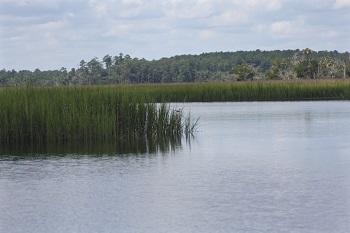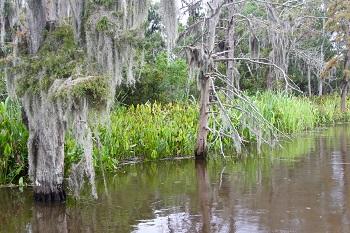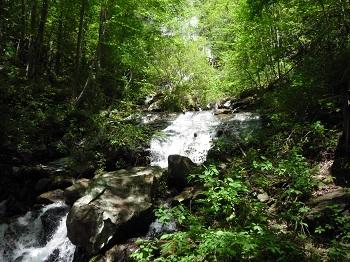
Water Quality in Georgia
Georgia 305(b)/303(d) Integrated Report

Section 305(b) of the Clean Water Act requires States to assess its water quality every two years. To develop this report, Georgia compares water quality data collected across the State against our Water Quality Standards using the State’s Listing Assessment Methodology and places each water into one of three broad assessment categories; 1) supporting their designated use; 2) not supporting their designated use; or 3) assessment pending. Section 303(d) of the Clean Water Act requires States to submit a list of all waters that are not supporting their designated uses and need to have a Total Maximum Daily Load (TMDL) developed.
Georgia publishes the 305(b)/303(d) integrated report which is titled “Water Quality in Georgia”, the 305(b)/303(d) list of waters is found in Appendix A of this report. This list is organized by waterbody type (e.g. Rivers/Streams, Lakes/Reservoirs, etc.), provides the name, location, and assessment category. If the designated use is not being supported, causes of impairment are listed along with potential sources of pollutants.
Prioritization Framework for Georgia 303(d) Waters

In December 2013, U.S. EPA released a document titled “Long-Term Vision for Assessment, Restoration, and Protection of waters under the Clean Water Act Section 303(d) Program” (2013 TMDL Vision). In 2015, GA EPD developed a
Priority
Framework
describing how GA EPD would prioritize waters on the 303(d) List for development of TMDLs or TMDL Alternatives and a
List
of Priority Waters
to implement the 2013 TMDL Vision. GA EPD has completed 100% of the plans for our 2013 TMDL Vision Priority Waters. These TMDL documents can be found on the Final TMDLs web page, under each individual river basin.
To bridge the period from the end of the first and the start of the second Long-Term 303(d) Program Visions (2022-2024), U.S. EPA asked States to provide a List of Priority Waters for which TMDLs, TMDL Alternatives or Protection Plans would be developed. During the “Bridge Period,” GA EPD focused on bacteria TMDLs. GA EPD completed Bacteria TMDLs for 164 waterbodies in Category 5 for fecal coliform on the 2022 303(d) list of waters. This allowed the 2024 303(d) list to be developed with no fecal coliform TMDLs needing to be established. In addition, EPD revised existing fecal coliform TMDLs developed by U.S. EPA from 1998 to 2006 that used a watershed modeling approach. These revised TMDLs were included to ensure all previously issued fecal coliform TMDL calculations used the loading curve approach currently being used to develop all bacteria TMDLs. These TMDL documents can be found on the Final TMDLs web page, under each individual river basin.
In September 2022, U.S. EPA released the updated document 2022 - 2032 Vision for the Clean Water Act Section 303(d) Program (2022 TMDL Vision). The 2022 TMDL Vision is a refinement of the 2013 TMDL Vision document that incorporated feedback from stakeholders and lessons learned. The 2022 TMDL Vision document and associated resources can be found on the U.S. EPA 303(d) Vision web page. The 2022 TMDL Vision statement is:
The Clean Water Act Section 303(d) program strives to strategically plan and prioritize activities, engage partners, and analyze and utilize data to develop water quality assessments, plans, and implementation approaches to restore and protect the Nation’s aquatic resources.
The ultimate endpoint of all water protection programs within GA EPD is the attainment of water quality criteria and support of a waterbody’s designated uses, ensuring the fulfillment the goal of the CWA that all waters be fishable and swimmable. GA EPD has developed a Prioritization Framework that provides a holistic strategy to be considered in the implementation of the 2022 TMDL Vision. GA EPD will use this framework to systematically prioritize waters or watersheds for TMDL, Restoration, and Protection plan development. GA EPD plans to engage the public and stakeholders by conducting outreach events, where information will be exchanged, and the public will be provided the opportunity to make recommendations on the 2022 TMDL Vision. Future meeting notifications will be shared through the GA EPD “Water Quality Standards, TMDLs, and Grants” GovDelivery email list. Please subscribe at the Watershed Protection Branch Updates page.
GA
EPD 303(d) TMDL Prioritization Framework - April 2024
Guidance for Submitting Data For 305(b)/303(d) Integrated Report
Most data used to develop the 305(b)/303(d) list of waters is collected by the Georgia Environmental Protection Division, one of our sister agencies (Wildlife Resource Division, Coastal Resources Division, Parks and Historic Sites Division) or the USGS. Third parties such as local governments, universities, environmental groups, industries, etc. also submit data for use in development of the 305(b)/303(d) list. In accordance with Chapter 391-3-6-.03(13) of the Rules and Regulations for Water Quality Control, outside parties who wish to submit data for use in the 305(b)/303(d) listing process must submit and receive approval of a Sampling Quality Assurance Plan (SQAP). The purpose of this plan is to ensure that the data collected is of sufficient quality and quantity to make sound assessment decisions. Guidance for preparing a submitting a SQAP is provided below.
-
Guidance On Submitting Water Quality Data For Use By The Georgia Environmental Protection Division In 305(b)/303(d) Listing Assessments (SQAP) [October 2002]
-
Guidelines for Using Third Party Biological Data for 305(b)/303(d) Purposes (Revised April 2019)
Deadlines for Submitting Data for Use in the 305(b)/303(d) Integrated Report
A
public
notice
soliciting data for use in the development of the 2026 305(b)/303(d) List of Waters was issued on January 30, 2025. Data are to be submitted by July 31, 2025. Details regarding requirements for submission of data can be found in the public notice

Georgia's 2024 305(b)/303(d) List Documents - Approved by U.S. EPA (September 3, 2024)
2024
305(b)/303(d) Integrated Report
Water Quality in Georgia (2022-2023)
This document can also be viewed online as an interactive story map.
Appendix A – 2024 List of Waters
-
2024 Rivers/Streams
-
2024 Lakes/Reservoirs
-
2024 Coastal Streams
-
2024 Sounds/Harbors
-
2024 Coastal Beaches
-
2024 Freshwater Beaches
The supporting documents below provide additional information regarding the 2024 305(b)/303(d) List of Waters. A brief explanation as to how the list was developed and a description of how it is organized is provided in “Description of the 305(b)/303(d) List of Waters”. It is recommended that those not familiar with the 305b/303d List of Waters read this document.
-
Description of the 305(b)/303(d) List of Waters
-
2024 Listing Assessment Methodology
-
Data Source/Code Key for Abbreviations for the 2024 list
-
Highlights of the 2024 List
-
Summary of 2024 Listing Decisions
-
Table of Changes between the 2022 and 2024 Lists
-
List of Waters whose GIS has been updated and whose names and location information may have been changed
-
2024 305(b)/303(d) List of Waters (in Excel Format)
-
Comments Received on the Draft 2024 305(b)/303(d) List
-
Response to Comments on the Draft 2024 305(b)/303(d) List
-
U.S. EPA Approval Letter of the 2024 303(d) List – September 3, 2024
Historical 305(b)/303(d) Documents

Georgia's 2022 305(b)/303(d) List Documents - Approved by U.S. EPA April 22, 2022
2022 305(b)/303(d)
Integrated Report
Water Quality in Georgia (2020-2021)
This document can also be viewed online as an interactive story map.
Appendix A – 2022 List of Waters
-
2022 Rivers/Streams
-
2022 Lakes/Reservoirs
-
2022 Coastal Streams
-
2022 Sounds/Harbors
-
2022 Coastal Beaches
-
2022 Freshwater Beaches
Supporting Documents
-
Description of the 305(b)/303(d) List of Waters
-
2022 Listing Assessment Methodology
-
Data Source/Code Key for Abbreviations for the 2022 list
-
Highlights of the 2022 List
-
Summary of 2022 Listing Decisions
-
Table of Changes between the 2020 and 2022 Lists
-
List of Changes between the Draft and Final 2022 List
-
List of Waters whose GIS has been updated and whose names and location information may have been changed
-
2022 305(b)/303(d) List of Waters (in Excel Format)
-
Response to Comments on the Draft 2022 305(b)/303(d) List
-
U.S. EPA Approval Letter of the 2022 303(d) List – April 22, 2022
2020 305(b)/303(d) Integrated Report (
Water
Quality in Georgia 2018-2019
)
Approved by U.S. EPA August 5, 2020
This document can also be viewed online as an interactive story map.
Appendix A – 2020 List of Waters
-
2020 Rivers/Streams
-
2020 Lakes/Reservoirs
-
2020 Coastal Streams
-
2020 Sounds/Harbors
-
2020 Coastal Beaches
-
2020 Freshwater Beaches
Supporting Documents
-
Description of the 2020 305(b)/303(d) List of Waters
-
2020 Listing Assessment Methodology
-
Data Source/Code Key for Abbreviations for the 2020 list
-
Highlights of the 2020 List
-
Summary of 2020 Listing Decisions
-
Table of Changes between the 2018 and 2020 Lists (Report version)
-
Table of Changes between the 2018 and 2020 Lists (Excel version with added fields)
-
List of changes between the draft and final 2020 Lists
-
2020 305(b)/303(d) List of Waters (In Excel Format)
-
Comments Received on draft 2020 305b/303d List
-
Response to Comments
-
U.S. EPA Approval Letter of 2020 303(d) List – August 5, 2020
2018 305(b)/303(d) Integrated Report (
Water
Quality in Georgia 2016-2017
)
Approved by U.S. EPA June 14, 2019
Appendix A – 2018 List of Waters
-
2018 Rivers/Streams
-
2018 Lakes/Reservoirs
-
2018 Coastal Streams
-
2018 Sounds/Harbors
-
2018 Coastal Beaches
-
2018 Freshwater Beaches
Supporting Documents
-
Description of the 2018 305(b)/303(d) List of Waters
-
2018 Listing Assessment Methodology
-
Data Source/Code Key for Abbreviations for the 2018 list
-
Highlights of the Draft 2018 List
-
Summary of 2018 Listing Decisions
-
Table of Changes between the 2016 and 2018 Lists
-
U.S. EPA Approval Letter of 2018 303(d) List – June 14, 2019
-
2018 305(b)/303(d) List of Waters (In Excel Format)
2016 305(b)/303(d) Integrated Report (
Water
Quality in Georgia 2014-2015
)
Approved by USEPA October 4, 2018
Appendix
A (2016 List of Waters)
-
2016 Rivers/Streams
-
2016 Lakes/Reservoirs
-
2016 Coastal Streams
-
2016 Sounds/Harbors
-
2016 Coastal Beaches
Supporting Documents
-
Description of the 2016 305(b)/303(d) List of Waters
-
2016 Listing Assessment Methodology
-
Data Source/Code Key for Abbreviations for the 2016 list
-
Highlights of the draft 2016 List
-
Summary of 2016 Listing Decisions
-
Table of Changes Between the Draft and Final 2016 Lists
-
Table of Changes between the Final 2014 and Final 2016 Lists
-
Response to Comments
-
U.S. EPA Approval Letter of 2016 303(d) List - October 4, 2018
-
2016 305(b)/303(d) List of Waters (In Excel format)
2014 305(b)/303(d) Integrated Report (
Water
Quality in Georgia 2012-2013
)
Appendix
A (2014 List of Waters)
-
2014 Rivers/Streams
-
2014 Lakes/Reservoirs
-
2014 Coastal Streams
-
2014 Sounds/Harbors
-
2014 Coastal Beaches
2012 305(b)/303(d) Integrated Report (
Water
Quality in Georgia 2010-2011
)
Appendix
A (2012 List of Waters)
-
2012 Rivers/Streams
-
2012 Lakes/Reservoirs
-
2012 Coastal Streams
-
2012 Sounds/Harbors
-
2012 Coastal Beaches
2010 305(b)/303(d) Integrated Report (
Water
Quality in Georgia 2008-2009
)
Appendix
A (2010 List of Waters)
-
2010 Rivers/Streams
-
2010 Lakes/Reservoirs
-
2010 Coastal Streams
-
2010 Sounds/Harbors
-
2010 Coastal Beaches
2008 305(b)/303(d) Integrated Report (
Water
Quality in Georgia 2006-2007
)
Appendix
A (2008 List of Waters)
-
2008 Rivers/Streams
-
2008 Lakes/Reservoirs
-
2008 Coastal Streams
-
2008 Sounds/Harbors
-
2008 Coastal Beaches
Appendix
B – Fish Consumption Guidelines for Year 2007
2006 305(b)/303(d) Integrated Report (
Water
Quality in Georgia 2004-2005
)
Appendix
A
(2006
List of Waters)
-
2006 Rivers/Streams Supporting Designated Uses
-
2006 Rivers/Streams Not Fully Supporting Designated Uses
-
2006 Lakes/Reservoirs Supporting Designated Uses
-
2006 Lakes/Reservoirs Not Fully Supporting Designated Uses
-
2006 Estuarine Waters Not Fully Supporting Designated Uses
-
Table of Beaches of Concern
Appendix
B – Waters Added to Georgia’s 305(b)/303(d) List by US EPA
Appendix
C – Fish Consumption Guidelines for Year 2005
2004 305(b)/303(d) Integrated Report (
Water
Quality in Georgia 2002-2003
)
2002 305(b)/303(d) Integrated Report (
Water
Quality in Georgia 2000-2001
)
305(b)/303(d) GIS Data Sets
GIS Data Sets (state-wide version) for Georgia's Integrated 305(b)/303(d) Reports can be found here. Also on this page are coverages of river basins, groundwater recharge areas, hydrologic unit codes (HUCs), landfills, RiverCare 2000, and the Georgia GIS Clearinghouse.